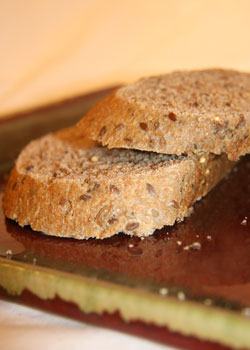1. Wheat is not genetically engineered (GE). There is no GE wheat approved or available for commercial sale anywhere in the world. Wheat is grown using traditional cross breeding methods, just as many other crops have been, for thousands of years.

2. Gliadin (a wheat protein) is not a new protein. Gliadin has actually been documented for over 100 years and can even be found in ancient grains as well.
 3. Some may suggest that wheat has an addictive property which leads to excessive consumption, but there is no reliable evidence to support that claim. Current evidence suggests that whole grain wheat has the ability to stimulate satiety hormones, not to mention the fiber from the whole grain leads to feeling full longer.
3. Some may suggest that wheat has an addictive property which leads to excessive consumption, but there is no reliable evidence to support that claim. Current evidence suggests that whole grain wheat has the ability to stimulate satiety hormones, not to mention the fiber from the whole grain leads to feeling full longer.

4. Whole grain products are linked to reduction in disease risk and lower body weights—specifically in the abdominal region. It is the refined grain products that are stripped of nutrients, antioxidants, and fiber almost entirely limiting their natural beneficial impact on health. These products are also often times high in fat and sugar.
 5. It takes a lot of bread to elicit a blood sugar response that is higher than a candy bar. The glycemic index is a number describing a specific food’s ability to raise blood sugars for every 50 grams of carbohydrate consumed—not 50 grams of that food itself—in relation to ingestion of 50 grams of straight glucose. It takes about 4 oz of whole grain bread (two of our big half inch slices) to get 50 grams of carbohydrate whereas it only takes 2.5 oz. of a candy bar to get those 50 grams.
5. It takes a lot of bread to elicit a blood sugar response that is higher than a candy bar. The glycemic index is a number describing a specific food’s ability to raise blood sugars for every 50 grams of carbohydrate consumed—not 50 grams of that food itself—in relation to ingestion of 50 grams of straight glucose. It takes about 4 oz of whole grain bread (two of our big half inch slices) to get 50 grams of carbohydrate whereas it only takes 2.5 oz. of a candy bar to get those 50 grams.
Check in for my next blog to learn 5 more ‘grains’ of truth regarding whole wheat and your health! Enter your email address in the box in the upper right corner and never miss a post.
Works Cited
Anwar M, Vatanparast H, Barlas S, Dehghan M, Shah S, Koning L, Steck S. Carbohydrate Intake and Overweight and Obesity among Healthy Adults. J Am Diet Assoc. 2009; 109:1165-1172.
Gaessaer, G.A., Angadi, S.S. Gluten Free Diet: Imprudent Dietary Advice for the General Population? Acad. Nutr. and Dietetics. 2012. 112: 1330-1333.
McKeown N, Troy L, Jacques P, Hoffmann U, O’Donnell C, Fox C. Whole and refined grain intakes are differentially associated with abdominal visceral and subcutaneous adiposity in healthy adult: the Framingham Heart Study. Am J Clin Nutr 2010; 92:1165-1171.
McKeown N, Yoshida M, Shea M, Jacques P, Lichtenstein A, Rogers G, Booth S, Saltzman E. Whole Grain Intake and Cereal Fiber Are Associated with Lower Abdominal Adiposity in Older Adults. J. Nutr. 2009; 139: 1950-1955.
Osborne, T.B. The Proteins of the Wheat Kernel. Carnegie Inst. of Washington. 1907. Publication No. 84, 5-119.
Wheat Improvement: The Truth Unveiled. The National Wheat Improvement Committee.Accessed March 2013. http://wheat.pw.usda.gov/ggpages/Wheat__Improvement-Myth_Versus_FactFINAL.pdf
Jones, J. Wheat Belly—An Analysis of Selected Statements and Basic Theses from the Book. Cereal Foods World. 2012. 57: 177-189.



